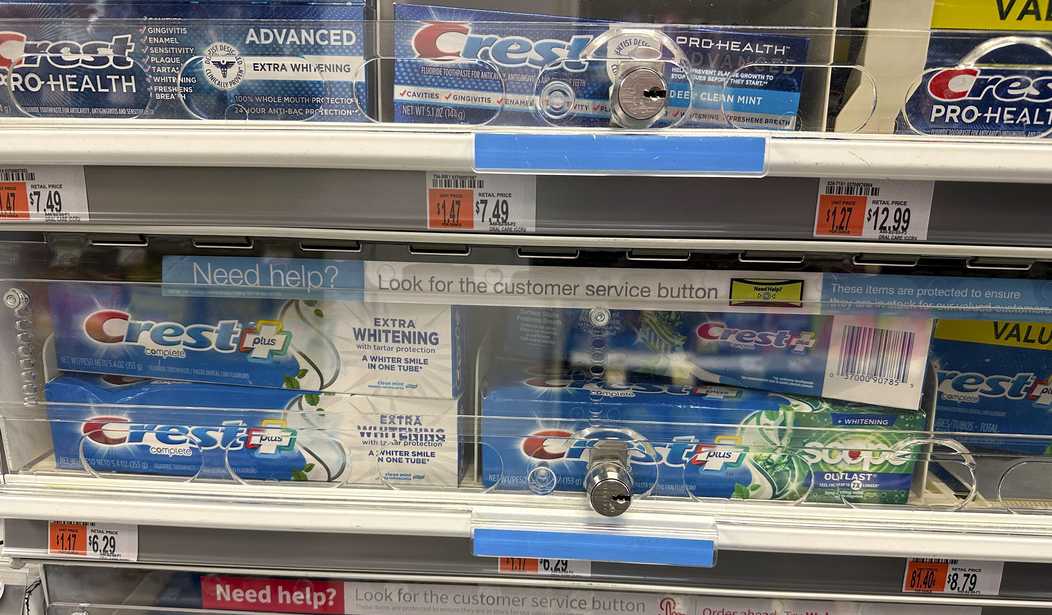While Democrats and their close friends and allies are assuring Americans that crime is decreasing, shoplifting and other forms of theft are becoming a massive problem for many communities across the country.
While violent crime is the primary concern for many Americans, this form of property crime also remains an issue. Perpetrators have become more emboldened over recent years as state and local governments, mostly in blue states, have relaxed their approach to theft.
A suspected shoplifter on Tuesday allegedly assaulted a mall manager with pepper spray at Washington Square Mall in Tigard, Oregon. The incident occurred after the manager confronted the individual over the alleged theft. Law enforcement responded to the scene, but the suspect had fled the premises before they came.
In Middle Tennessee, meanwhile, authorities arrested a woman after a year-long shoplifting spree across various stores in the area. The 29-year-old woman allegedly pilfered merchandise from several locations, including department stores and supermarkets.
Law enforcement estimates that she stole thousands of dollars in products. She is now facing multiple theft-related charges.
Police in Charleston County, South Carolina, apprehended two suspected shoplifters following a high-speed chase on Monday. The suspects had fled from a store at which they were allegedly caught trying to steal merchandise. Both individuals are facing charges for theft and evading law enforcement.
Related: SURPRISE: The FBI Just Stealth-Edited Its Violent Crime Rate, Blows Up Democrat and Press Narrative
These three stories are but a smattering of what is happening all over America – especially in major cities. In many cases, these people get lenient punishment, if they are even punished at all. The result has been stores having to lock up merchandise, which inconveniences paying customers. Many stores in California, New York, and other states have closed up shop because they could not afford to continue sustaining losses caused by the myriad of shoplifting rings that have cropped up over recent years.
In a piece for The Atlantic, author Marc Fisher examines the growing prevalence of shoplifting in America and the challenges retailers face in addressing this problem.
Retailers are increasingly locking up everyday items behind Plexiglas and elsewhere, which has frustrated customers. The author recounts noticing this while conducting his investigation into the matter.
I counted 21 aisles of goods locked behind plastic, including toothpaste, body wash, underwear, earbuds, and air fresheners—all items that impulse thieves and organized criminals alike find desirable.
Fisher stresses that the problem goes much further than viral videos of shoplifters circulating on social media – it is actually affecting the bottom line of many retailers, which is why they are locking up their products. “Companies are doing it because they’re seeing their goods walk out the door, costing them billions,” he writes.
Unfortunately, adding physical barriers creates other problems: Annoyed customers.
A senior executive at a national chain store was equally frustrated. He spoke with me on the condition of anonymity, because his bosses didn’t want the debate over shoplifting to tarnish the company’s brand. His stores lock up products even though they know it chases away paying customers and is an ineffective barrier against professionals. ‘They pop the locks; they melt the glass; they take the keys out of employees’ hands.’
Traditional security measures that might have deterred would-be shoplifters in the past have largely been abandoned or made impotent because of changes in the rules of engagement and the fear of legal repercussions. Gone are the days when a security guard could tackle someone stealing products and hold them for law enforcement.
Guards aren’t the answer... New engagement rules at many retail stores discourage police and security guards from using force to stop offenders—they can no longer grab and cuff shoplifters.
One security guard told the author that he was “just a visual deterrent.” However, more criminals are seeing that security personnel are unable to act even in the face of blatant theft.
Fisher also brings up the problem of organized retail crime, which is now a thing in many major cities. “Organized retail crime... often involves ringleaders ordering up shopping lists of goods they’ve often already sold to customers online,” he writes.
To add further insult to injury, the shoplifters “advertise their loot on Facebook and eBay, and trade tactical tips on Reddit as well as on more obscure sites,” according to the author.
So, if the government isn’t going to take action against thieves, what can retailers do to protect their property? Artificial Intelligence technology has shown some promise even though the results have been mixed so far. “AI doesn’t get bored monitoring video, so it can watch the parking lot and alert store clerks if someone walks toward the shop carrying a crowbar,” Fisher writes.
AI can alert store owners if an individual is behaving suspiciously, drawing attention to the individual so employees can keep an eye on them. However, one store owner indicated that it works about half of the time. In many cases, they give false alarms.
The author indicates that the outbreak in property crime could prompt a shift back to harsher enforcement of the law. “In the past few years, states such as Florida, North Carolina, and Louisiana have ratcheted up penalties, especially for people caught stealing in a group,” he writes.
He added: “Next month, Californians will vote on a referendum that would toughen penalties for shoplifting, essentially undoing the reforms voters approved just a decade ago.”
Organizations like the National Association for Shoplifting Prevention are focusing on educational programs to address shoplifters’ motivations – especially for casual or first-time offenders.
Barbara Staib, an executive at the National Association for Shoplifting Prevention, has been at this for a quarter of a century. She’s seen fancy fixes come and go. “You can keep going with your technology and your solutions and all the innovation in the world, but if you don’t address motivations, you’re not going to get anywhere,” she told me. That could mean getting shoplifters into counseling, rehab programs, food-assistance services, and job-training classes. Sometimes, especially with casual thieves, a few hours of education about the impact that shoplifting can have on their own friends and family—raising prices, closing stores—can make a difference. Staib’s organization offers a four-hour course focused on sending shoplifters the message that their behavior isn’t harmless. It seems to help: A four-year study in King County, Washington, found that fewer than 6 percent of young people who finished the course were nabbed again for shoplifting.
It appears that dealing with shoplifting will require a multi-pronged approach. Enforcement is key, as is understanding the motivation behind the crimes. As Staib suggested, many who steal from retail stores likely believe they are not actually hurting anyone as the company can afford to absorb the loss. Education seems to help in this regard.
However, there are those who shoplift because it is a way to make an income. Others do it for ideological reasons, a way to strike back at the evil capitalist system. For these folks, harsher law enforcement might be the best way to address the problem.
Unfortunately, while some localities and states might wake up to the fact that leniency isn’t helping, others will stay the course for ideological reasons. After all, it’s not exactly progressive to crack down on those who steal from big bad corporations, is it?













